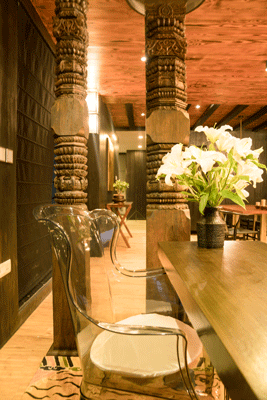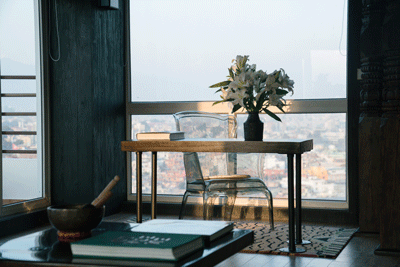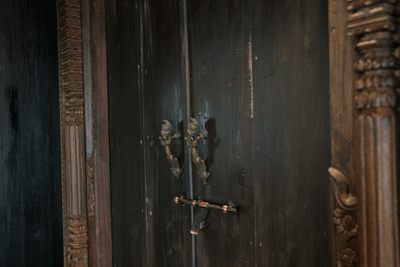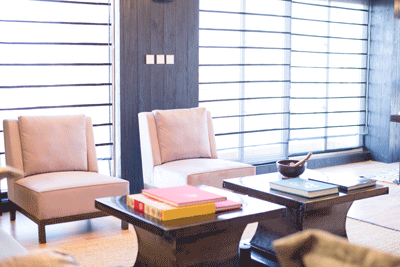An Oasis in the City
In the midst of a city heavily influenced by modernization is a haven designed with bold juxtaposition of both flamboyant, ornate furnishing and modest antique décor.
 Located in the vicinity of expat enclave of Jhamsikhel, this luxury apartment is nestled in the tenth floor of an exclusive high-rise building, with a magnificent view of the snow capped Himalayan range, and Swayambhu, and the glitter of the city lights after dusk.
Located in the vicinity of expat enclave of Jhamsikhel, this luxury apartment is nestled in the tenth floor of an exclusive high-rise building, with a magnificent view of the snow capped Himalayan range, and Swayambhu, and the glitter of the city lights after dusk.
The interior of the apartment was designed by a Phuket, Thailand based Interiors Designer, and the designer, to her great credit, has turned it into a truly unique and luxurious space.
Inspired by the traditional arts and crafts of Nepal, the designer has managed to fuse the ancient and the contemporary in a seamless way. She had the support of expert craftsmen of Kathmandu valley working on various elements such as stone, brass, copper, and wood.
“The whole apartment can be controlled by just a touch of the finger,” she tells me as she uses the finger sensor to open the door of the apartment. As we enter, I am greeted by five intricate stone sculptures of small and ferocious lions. She then goes on to touch the first switch, which turns on all the lights of the apartment. She tells me that all the lighting, curtains and sound systems can be easily controlled by using a smart phone or a tablet, removing the need to search for switches.
From the ceilings to the walls to the floor, we see a generous use of wood in the apartment. The floor has been laid with a natural beige parquetry while the ceilings have been reflected with tones of Vermont maple wood. The walls on the other hand, have been clad with pinewood and treated with fire by professionals to get the dark ebony shades of burnt pinewood, which manage to give a sophisticated and mystical charm to the space. It is this warm hues of the dark burnt wood that give a very timeless traditional quintessence to the place.
 The living area has been designed with a careful juxtaposition of both flamboyant, ornate furnishing and modest, antique decor. Each decorative piece of furnishing in the living and dining area is unique in its own right as most of the pieces were designed by the interiors decorator herself. The artfully hammered copper coffee tables give a contemporary charm to the area, which is decorated with a range of illustrated coffee table books and an antique singing bowl placed on top. The vintage green sueded oversized sofa is as luxurious as they come, and is complemented by the chic light pink suede chauffeur chairs. The super soft sisal rugs have been brought from the southern Nepal and the carpets are all made of Himalayan wool. To add to the antique and avant-garde look, the hand-made chandeliers have been iron cladded.
The living area has been designed with a careful juxtaposition of both flamboyant, ornate furnishing and modest, antique decor. Each decorative piece of furnishing in the living and dining area is unique in its own right as most of the pieces were designed by the interiors decorator herself. The artfully hammered copper coffee tables give a contemporary charm to the area, which is decorated with a range of illustrated coffee table books and an antique singing bowl placed on top. The vintage green sueded oversized sofa is as luxurious as they come, and is complemented by the chic light pink suede chauffeur chairs. The super soft sisal rugs have been brought from the southern Nepal and the carpets are all made of Himalayan wool. To add to the antique and avant-garde look, the hand-made chandeliers have been iron cladded.
The most creative addition to the living area is the two big wooden pillars that have bold and intricate designs with Garudas. Apart from acting as a partition to give privacy to the work station, they add a magical element to the living space. Although she had to wait for six months for all of her wooden crafts to be completed, it was definitely worth the wait. Also, it took around ten men to carry the main pillars all the way to the tenth floor.
 As I looked around, I also caught sight of -- what I thought -- was a big, transparent plastic study chair. I was told that it is French designer Philippe Starck’s Ghost Chair —ordered from overseas — and is actually a high-quality polycarbonate Louis XV chair. As its name boldly hints, the chair doesn’t appear to take any space in the apartment. Three study desks in this apartment have been paired with Ghost Chairs throughout the living and bedroom areas.
As I looked around, I also caught sight of -- what I thought -- was a big, transparent plastic study chair. I was told that it is French designer Philippe Starck’s Ghost Chair —ordered from overseas — and is actually a high-quality polycarbonate Louis XV chair. As its name boldly hints, the chair doesn’t appear to take any space in the apartment. Three study desks in this apartment have been paired with Ghost Chairs throughout the living and bedroom areas.
Moving on to the dining area, the dining table is composed of a strong marblewood, which has been cladded with brass legs. They form a playful setup with the Wishbone chair by Swedish designer Hans J. Wegner. The international designer’s furniture has been beautifully complemented with the locally handmade table.
Another exciting feature is—what the designer likes to call—the Ninja cabinet. An interesting cabinet is hidden behind the dark wooden walls of the dining area, accessing which requires one to push the wooden wall. It is a great place to store wine and champagne crystal glasses for any celebration.
One of the highlights of the dining area is the full-sized ancient style wood carving that adorns the door to the kitchen. This floor to ceiling wooden art certainly feels like it belongs there, and exudes a luxurious and palatial look.
 I also noticed the plentiful use of the golden tinctures of brass, copper and bronze in the apartment. The designer has added an unconventional piece of artwork near the dining area that is comprised of only brass. It took me by surprise to see how something like hammered brass can look this beautiful.
I also noticed the plentiful use of the golden tinctures of brass, copper and bronze in the apartment. The designer has added an unconventional piece of artwork near the dining area that is comprised of only brass. It took me by surprise to see how something like hammered brass can look this beautiful.
Along with the furniture, she has added various elements to the area through decorative items to maintain the traditional theme. One of the amazing details is a vertical inlaid golden brass line across the dark wooden wall of the living room wall that sums up what is at display in the apartment, a harmony of all elements that creates a beautifully balanced feeling.
The balcony too shares the same natural essence of the interiors as its walls have been covered with stones. The rustic texture of stone, though contrasting to the traditional consistency of wood, has added an organic and eco-friendly presence to the exterior.
We then went back in through the expansive glass windows to check out the apartment’s bedrooms. The bedrooms feature specially designed and order made brass headboards and table lamps handcrafted in Patan. The amazing walk-in closet is hidden in the master bedroom. The doors slide open gracefully at the push of a brass handle with a warm light inviting you in.
I was really impressed with how Nepalese designs and influences could merge so seamlessly with a luxurious and contemporary style. This interior has been designed with whole different approach from what we have seen in recent times. While most residences in the city have been heavily influenced by modernization, this peaceful refuge has aesthetically fused both traditional and contemporary décor. The interiors showcase the wonders that local Nepali artisan can produce to fill the vacuities of a house, and not everything needs to be imported to create a high-end level of luxury, and comfortable living. This apartment is a work of art—a sanctum of sophistication and antiquity.
Special thanks to,
The designer : MAPLE
coconnutgrooveinteriors@gmail.com
Credit photographer : Samir Maharjan & SJBR


